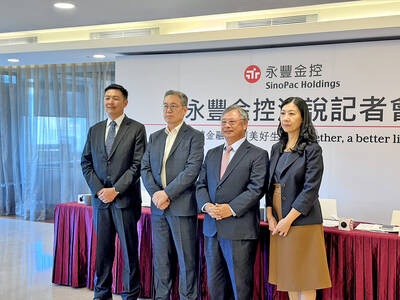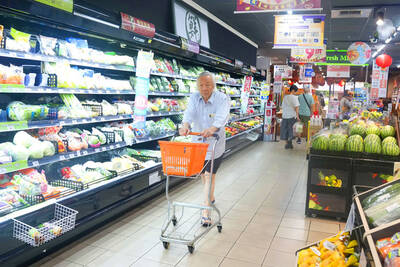CSBC Corp, Taiwan (台灣國際造船) yesterday confirmed that cracks have appeared in the welding joints of transition pieces it supplied to Orsted Taiwan Ltd’s (沃旭能源) offshore wind farm projects, but dismissed speculation that it could lead to Orsted switching to foreign suppliers.
“This is a repairable problem and we are working with China Steel Corp [CSC, 中鋼] on updating our welding process specifications so we can deliver a product that is satisfactory to Orsted,” CSBC spokesman Mike Chou (周志明) told the Taipei Times by telephone.
Chou’s remarks came after a report yesterday by the Chinese-language Commercial Times, which, citing an anonymous source at CSBC, said cracks have appeared in the welding of Taiwan-made wind turbine components for Orsted’s Greater Changhua 1 & 2a Offshore Wind Farms.
The report said multiple sources confirmed that transition pieces made by CSBC, which were delivered in June, started developing cracks in the welding joints three to four months after delivery.
The issue has already caused “a nine-month delay” and could lead to Orsted “cutting its order and switching to South Korea,” it said.
Chou said that most of the story was “pure speculation.”
The cracked welding material would be removed and the transition piece would be rewelded according to new specifications, he said.
“We will expand the area around the joint that we heat before welding and cover it with fiberglass insulation after welding to minimize rapid temperature change. This should help reduce residual stress,” Chou said.
Residual stress, which is the internal stress that remains inside an object after external loading forces are removed, is a cause of premature structural failure.
Orsted has contracted CSC to execute the underwater construction of 56 turbine platforms for the wind farms. CSC then contracted the welding of 22 of 56 transition pieces to CSBC. The transition piece is part of the foundation of the unit and connects the monopile to the tower.
CSBC is waiting for CSC and Orsted to sign off on the new welding process specifications before repairing the pieces, Chou said.
CSC executive vice president and spokesman Hwang Chien-chih (黃建智) described the faults as “a part of the learning process” for Taiwanese companies making wind farm components for the first time.
“These pieces are the size of a three-story building,” Hwang said. “We are working with Orsted intensively. Our experts agree with their experts about [the need to reduce residual stress].”
Orsted said it is “going all out” to support suppliers with “extra assistance to ensure the necessary quality” as new suppliers in Taiwan face “challenges in their learning curves.”
“However, our top priority remains to deliver the Greater Changhua 1 & 2a offshore wind project safely, on time and on quality. If the local suppliers are still struggling to meet the requirements and delivery schedule, Orsted will have to take necessary actions to ensure the project time line will not be jeopardized,” the company said in an e-mailed statement.
Under the government’s offshore wind farm localization policy, developers are required to use certain made-in-Taiwan components, even if imported components might have a price and quality advantage.
Deputy Minister of Economic Affairs Tseng Wen-sheng (曾文生) said the faulty components are an “issue of commercial contract obligations” and are separate from the government’s localization policy.
“The hope is as companies meet with technical challenges [in localizing offshore wind] they will overcome them,” Tseng said.

On Tuesday, US President Donald Trump weighed in on a pressing national issue: The rebranding of a restaurant chain. Last week, Cracker Barrel, a Tennessee company whose nationwide locations lean heavily on a cozy, old-timey aesthetic — “rocking chairs on the porch, a warm fire in the hearth, peg games on the table” — announced it was updating its logo. Uncle Herschel, the man who once appeared next to the letters with a barrel, was gone. It sparked ire on the right, with Donald Trump Jr leading a charge against the rebranding: “WTF is wrong with Cracker Barrel?!” Later, Trump Sr weighed

SinoPac Financial Holdings Co (永豐金控) is weighing whether to add a life insurance business to its portfolio, but would tread cautiously after completing three acquisitions in quick succession, president Stanley Chu (朱士廷) said yesterday. “We are carefully considering whether life insurance should play a role in SinoPac’s business map,” Chu told reporters ahead of an earnings conference. “Our priority is to ensure the success of the deals we have already made, even though we are tracking some possible targets.” Local media have reported that Mercuries Life Insurance Co (三商美邦人壽), which is seeking buyers amid financial strains, has invited three financial

Artificial intelligence (AI) chip designer Cambricon Technologies Corp (寒武紀科技) plunged almost 9 percent after warning investors about a doubling in its share price over just a month, a record gain that helped fuel a US$1 trillion Chinese market rally. Cambricon triggered the selloff with a Thursday filing in which it dispelled talk about nonexistent products in the pipeline, reminded investors it labors under US sanctions, and stressed the difficulties of ascending the technology ladder. The Shanghai-listed company’s stock dived by the most since April in early yesterday trading, while the market stood largely unchanged. The litany of warnings underscores growing scrutiny of

OUTLOOK: Among the six sub-indices, only the stock market confidence sub-index rose due to strong equity performance and expectations of a US Federal Reserve rate cut Consumer confidence weakened further this month, sliding to its lowest level in two-and-a-half years as households grew increasingly uneasy about the economic outlook, job security and big-ticket spending, a survey by the National Central University showed yesterday. The consumer confidence index fell 1.07 points from last month to 63.31, the weakest number since May 2023, said the university’s Research Center for Taiwan Economic Development (RCTED), which conducts the monthly poll. “Although the Directorate-General of Budget, Accounting and Statistics recently increased Taiwan’s GDP growth forecast for this year to 4.45 percent, consumer sentiment tells a different story,” RCTED director Dachrahn Wu